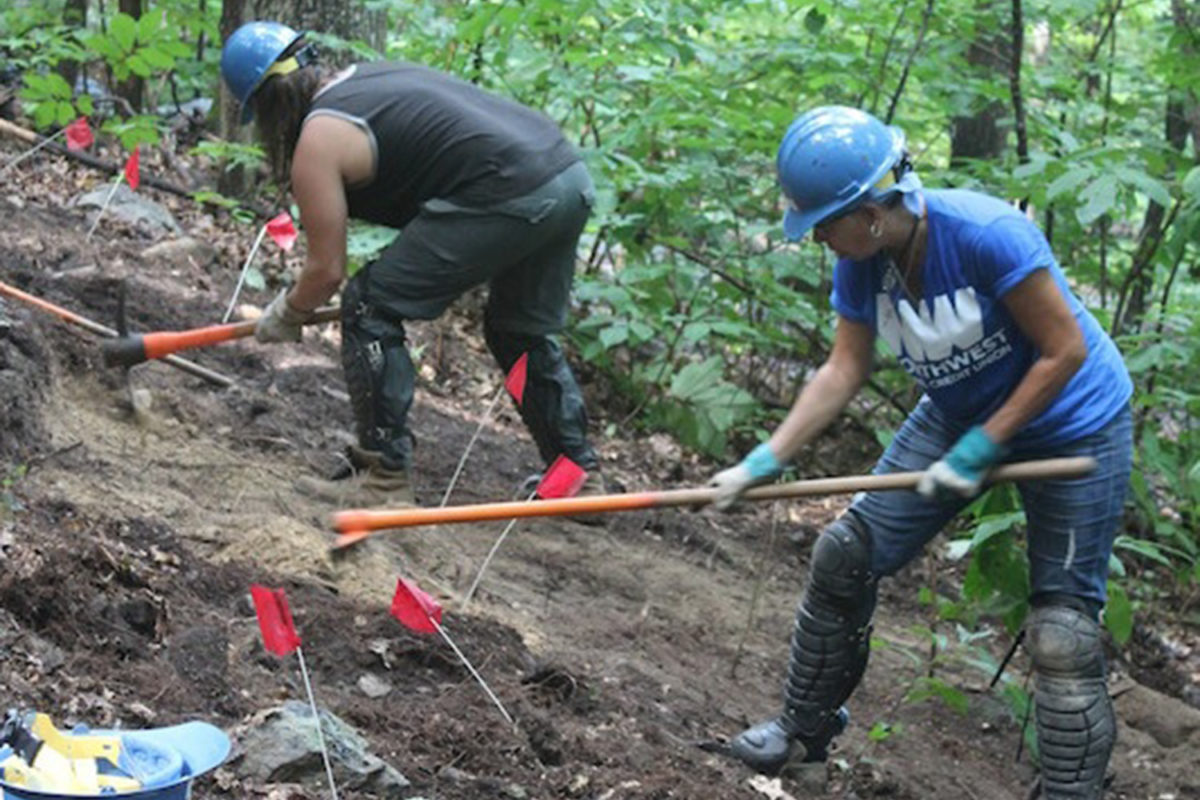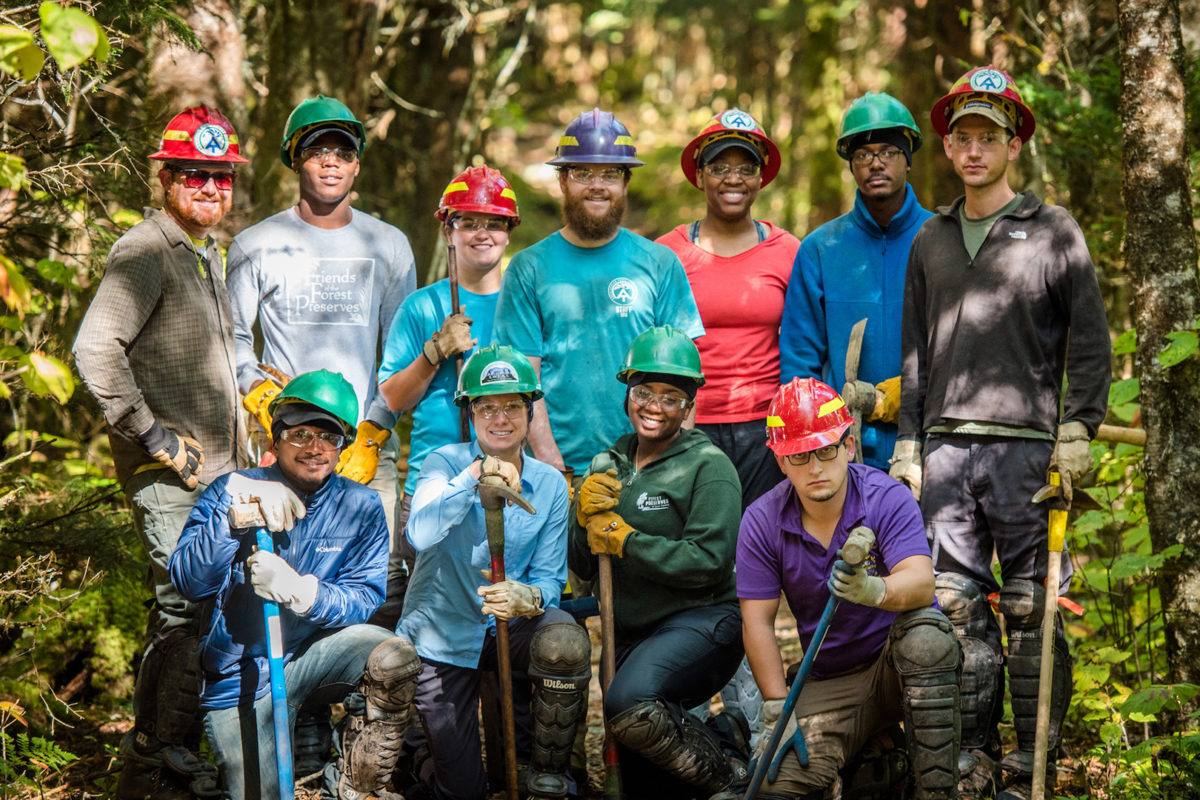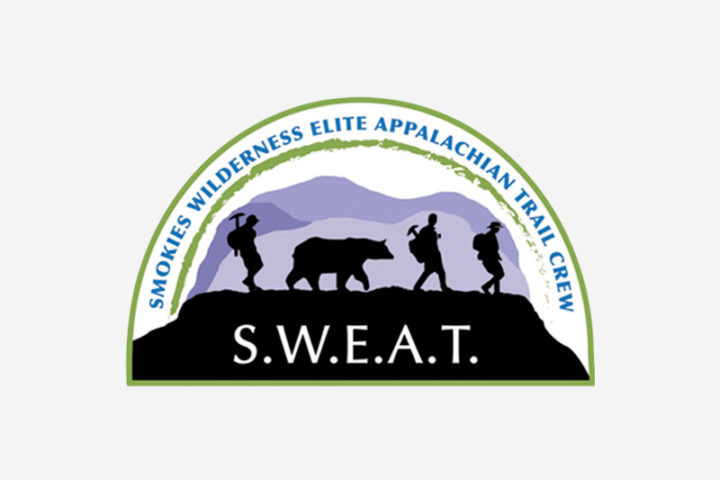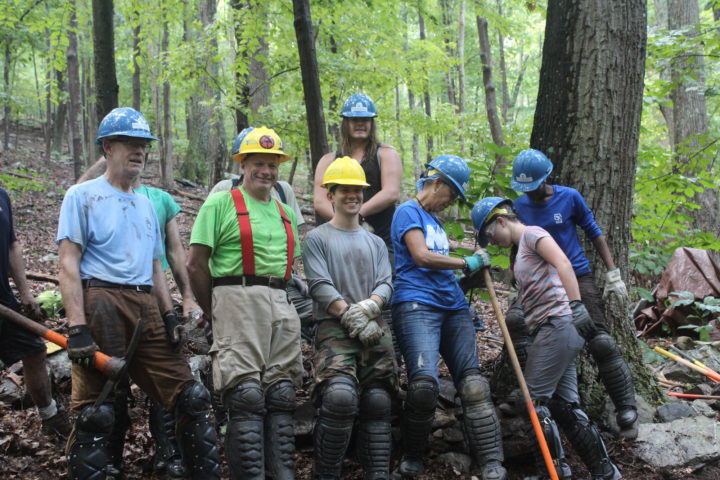Learn More
Trail Crews
The volunteer Trail Crews listed below tackle large-scale projects such as Trail relocations and rehabilitation and bridge and shelter construction.
Trail management encompasses the on-the-ground stewardship performed by volunteers and agency partners to maintain the Trail, its structures, and its natural and cultural resources. It includes keeping the footpath clear of natural overgrowth and blowdowns; building and relocating sections of the footpath; building and repairing shelters and other structures; and caring for overnight sites. We coordinate this work, provide training, help set policy parameters, supply funding and other assistance to 30 Trail clubs, and recruit and manage volunteer Trail Crews.
Our stewardship efforts include educating and supporting A.T. users to adopt hiking and camping techniques that minimize damage to the natural environment. We promote Leave No Trace principles and deploy ridgerunners and caretakers along high-use sections of the Trail to help hikers and other visitors understand those principles and avoid unnecessary resource damage.
To help ensure consistent management practices along the roughly 2,190 miles of the Trail, we provide a number of resources for volunteer leaders, agencies and others, including a library of A.T. management policies and other reference materials.
The Appalachian Trail Crews
The volunteer Trail Crews listed below tackle large-scale projects such as Trail relocations and rehabilitation and bridge and shelter construction. The crews are active from May through October each year, working on projects from Maine to Georgia. Trail Crew projects—which last for a week or more—are planned and completed in cooperation with A.T. maintaining clubs and agency partners such as the National Park Service and the U.S. Forest Service. Applications for these crews may be submitted using the links below.
Volunteers of 31 designated A.T.-maintaining clubs do most of the day-to-day work on the Appalachian Trail. More about the Trail clubs and their volunteer opportunities can be found on their websites, using the links found here.

Crew Life
All crew members must be able to live and work cooperatively and in close proximity with fellow volunteers of all genders, ages, and nationalities. All crew members are expected to participate equally in routine tasks, including cooking, cleaning, and tool care, both at base camp and the project site.

Working Conditions
TRAIL WORK IS HARD, PHYSICAL LABOR. It involves working with hand tools, and getting dirty is guaranteed. The crews work eight- or nine-hour days, rain or shine, hot or cold, regardless of black flies, mosquitoes, and other insects. During the course of the crew season, the weather can vary from sweaty, summertime heat to freezing, winter-like cold.


On the Site
Crews gather at base camp for introductions and orientation the day before departing to spend the work week at the project location. Accommodations at the project sites vary, ranging from primitive backcountry tent camps to tenting in developed campgrounds to cabins accessible by vehicle. On crews working at remote backcountry locations, participants may have a lengthy and strenuous full-day backpack with significant elevation gain to their field campsite, and a primitive backcountry experience without showers, bathrooms, or running water for the duration of their week. These crews carry in food, tools, and group gear in addition to their personal equipment. Most crews can expect a hike to the work site each morning.

Staff
Crews are led by experienced, professional crew leaders eager to pass along Trail work and backcountry skills. Camp coordinators supervise life at base camp and provide administrative and logistical support. Some camp coordinators serve as assistant crew leaders in the field. Applications for seasonal Trail crew staff are available in the winter under Job Opportunities. The application deadline is Jan. 31. Trail club members may join the crews in the field and may be involved in project administration.


What We Provide
Once you arrive at the base camp, shelter, food, transportation to and from project sites, tools, safety equipment, and group camping gear (as available) are provided. Crew members need to bring work clothing, sturdy boots, and their own basic camping gear.
Learn more about each crew

Volunteer
Rocky Top Trail Crew
Experience the Smoky Mountains from a different perspective this fall working and camping on the Appalachian Trail.

Volunteer
Konnarock Trail Crew
Konnarock is the Appalachian Trail Conservancy's flagship crew program, founded in 1983 and named after its original base camp in southwest Virginia.

Volunteer
S.W.E.A.T. Crew
“Elite” is the operative word. This A.T. crew is arguably the most challenging since it addresses trail maintenance issues deep within the most remote backcountry areas of the Great Smoky Mountains National Park.

Volunteer
Maine Trail Crew
Spend a week in the scenic Maine woods this summer working and camping on the Appalachian Trail. The Maine Trail Crew, sponsored by the Maine Appalachian Trail Club and the Appalachian Trail Conservancy is based in central Maine.

Volunteer
Volunteer Long Trail Patrol
Experience life on the Long Trail. Sponsored jointly by the Green Mountain Club and the ATC, the Volunteer Long Trail Patrol (VLTP) works on heavy construction projects on hiking trails in Vermont, including the co-aligned Appalachian Trail and Long Trail.

Volunteer
Mid-Atlantic Trail Crew
Based near Carlisle, Pennsylvania, the Mid-Atlantic Crew works on the Appalachian Trail from Rockfish Gap in Virginia to the New York–Connecticut state line.
In addition to these crews, there are 31 Trail Maintaining Clubs working up and down the entire Appalachian Trail. Volunteers at these clubs do trail maintenance, monitoring, section planning and a lot more!
Ridgerunners and caretakers
![]() Ridgerunners and caretakers are seasonal employees assigned to hike and camp along high-use sections of the A.T. and at heavily used overnight sites. The ridgerunner and caretaker program helps promote a quality recreational experience for all.
Ridgerunners and caretakers are seasonal employees assigned to hike and camp along high-use sections of the A.T. and at heavily used overnight sites. The ridgerunner and caretaker program helps promote a quality recreational experience for all.
Ridgerunners are assigned to work on specific sections of the Trail, which can be up to 70 miles long. They spend most of their work day on the Trail, talking to hikers and other Trail visitors. At trailheads they may discuss hikers’ itineraries, potential campsites and the importance of using already impacted campsites in heavily used areas. At campsites and shelters they might talk about effective food storage in bear country or area campfire policy.
These trail stewards make note of the condition of the Trail itself, campsites, shelters or other built structures and report any conditions that need immediate attention to maintaining clubs and agency partners. While infrequent, ridgerunners occasionally become involved in emergency responses, including searches for lost hikers or efforts to provide emergency medical treatment to ill or injured hikers.
We recruit for the upcoming season during November or December of the prior year. Information and applications are found in the Job Opportunities section. Applications are usually accepted until Jan. 31. More information can also be obtained by calling the ATC’s Ridgerunner Coordinator at 717.258.5771 x203.
Trail management policies
We adopt policies in order to state ATC’s position on issues affecting the Trail and to facilitate consistent management of the Trail through 8 national forests, 6 national parks, 14 states and numerous state and local jurisdictions. Policies are developed in consultation with agency partners and the Trail clubs, whose members volunteer more than 200,000 hours annually to the Trail. This diagram depicts the ATC Policy Development Process (pdf).





